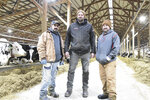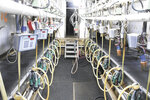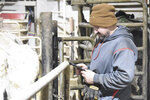


FREEPORT, Minn. — When Chris Middendorf added a robotic milking system to his freestall barn a year ago, he intended to use the facility in tandem with his already existing double-8 parallel parlor.
“It was either this or build another parlor because we had outgrown our parlor,” Middendorf said. “It was taking too long to milk cows in it.”
At first, he thought about building a rotary parlor, Middendorf said. But after talking with technicians at Leedstone in Melrose, he decided to install robots and then visited a few farms to learn more.
On Dec. 1, 2022, six Lely 5 Astronaut robotic milking units were installed in Middendorf’s extended freestall barn on his farm near Freeport. Currently, 390 cows are milked with the robots and 240 cows are milked in the parlor. Cows are milked by the system of which they are best suited. Milk is shipped to First District Association in Litchfield. Middendorf farms 1,800 acres to feed his herd and sells extra corn as a cash crop.
The plan to use two milking systems is working well, Middendorf said. However, he and his employees experienced an initial learning curve.
“Another guy with robots told me it would take a whole year before you finally get settled in with them, and he wasn’t wrong,” Middendorf said. “I’d say the last three months we’ve been settled in with them.”
Cows in the freestall barn now average 2.8 daily visits to the robots. In the parlor, two daily milking shifts take four hours each to complete, shifts that are far shorter than when the entire herd was milked in the parlor.
“Each shift was taking eight hours to milk, and it was so hard on labor and keeping people here milking eight hours straight,” Middendorf said.
Now he has one full-time employee managing the parlor and another overseeing the robotic milking. Four other employees work during the day and three work at night. There are 11 employees in all. Middendorf’s wife, Deana, handles all bookwork for the farm, and their three children — two in high school and one in college — help when needed.
“We have the same number of employees as before, but it seems they put in fewer hours now,” Middendorf said.
The biggest benefit of the robots, Middendorf said, is their contribution to better herd temperament. He noticed immediately that the cows using the robots became calmer.
“It was like you flipped a light switch; I couldn’t believe it,” Middendorf said. “You can tell the cows are going to last longer because they are so much calmer and can come and go and do what they want when they want. When I walk through the parlor group of cows, it’s different. They start to run around and are jumpier.”
The robots give useful data for keeping track of cows such as how many times they have been through the robots and how long it takes them to be milked. Robots also collect information on milk conductivity and somatic cell count. The system includes a separation pen with an air-operated gate that can be controlled by the robots. This is used to sort cows into the separation pen without employees having to fetch them.
“We set criteria with the computer, and you can adjust it for how sensitive you want it,” Middendorf said. “The way we have it set up now, if a cow comes through the robot and she isn’t feeling well or coming down with something, the robot will automatically route her to the separation pen in the back so that you don’t have to go find her. It has really helped us stay on top of mastitis issues.”
The robots are also set to sense cows in heat and route them to the separation pen. Herd health checks are now faster because the robots can separate the group of cows to be checked.
“Before when we did herd health, it was taking us four hours twice a month; now we do it in under four hours for the whole month,” Middendorf said. “We basically cut our time the vet was here in half.”
The parlor built in 1992 is in good shape, Middendorf said. Cows milked in the parlor are housed in two smaller barns. Parlor cows are selected because they have teat issues, are slow milkers or have other characteristics that do not mesh well with the robotic milking system. Sick cows are milked in the parlor because a robot must go through a 10-minute cleaning after a treated cow is milked, slowing down access for other cows.
“You could milk two cows in that time,” Middendorf said. “A lot of cows average seven minutes (per robot use). When you get some of these cows that are only giving 70 or 80 pounds of milk and are taking 12 minutes to milk, they aren’t worth having up here (on robots).”
Middendorf raises his heifers and trains all of them on robots for their first lactations. Heifers that do not work well in the robots during their first lactation may do well in their second lactation. Though they are milked in the parlor the first time, Middendorf gives them another chance with the robots for their second lactation. Sometimes there is success the second time around because the cow has been exposed to the robots and is larger in her second lactation.
“It’s a lot easier to train them as heifers than when they are older,” Middendorf said.
Fast milking speed and good connectivity, he said, are the main factors that determine a cow’s success with the robots. But other variables matter as well. Data retrieved by the robots helps Middendorf discover those variables. For instance, Middendorf and his nutritionist tried to determine why they were struggling to get adequate amounts of milk from some of the heifers. By evaluating bodyweight data collected by the robots, it was discovered that lighter heifers struggled the most.
“We adjusted how old heifers are when we breed them,” Middendorf said. “We just try to get them a little bigger when they come in now. We never would have been able to figure that out if the robots didn’t have scales.”
They will evaluate the production of first-lactation heifers to determine if the adjustment worked.
Middendorf said his decision to use both systems is one that other farmers are making as well. No one wants to sell good milking cows just because they have an unusual udder or do not adjust well to robots.
“That’s just heartbreaking to have to sell a cow like that, but the idea used to be, if you got robots, you shut down your parlor and walked away from it,” Middendorf said. “They started singing a different tune the last number of years. … The parlor and robots kind of complement each other.”
Mark Klaphake contributed to this article.
Comments
No comments on this item Please log in to comment by clicking here